
Whether you find math to be like a pleasant beachfront stroll or more like ascending an icy mountain in freezing winds, we can help you ace the Quantitative Reasoning GRE section. In this total guide to GRE quantitative, we’ll provide an overview of the GRE Quantitative section, go in-depth on each of the question types, offer advice on how to prepare, and give GRE math tips for test day domination! We even have some special tips for those of you going for that perfect 170 on the GRE Quantitative Reasoning section.
GRE Quantitative Reasoning Section: An Overview
The quantitative section, unsurprisingly, tests your math skills. Most of the GRE math topics are things that you probably learned in high school. So the math itself isn’t that advanced. However, GRE quantitative focuses primarily on critical thinking and problem-solving skills. The majority of GRE quantitative questions won’t require tons of number-crunching if you know how to approach them, but they will require thinking about foundational math concepts in innovative ways.
Expect to see questions in the following topic areas:
Arithmetic
- Number theory/integer properties: factorization, prime numbers, remainders, divisibility, odd/even integers
- Basic operations: addition, subtraction, division, multiplication, and exponents (think PEMDAS), and roots
- Other topics: estimating; percents, ratios and rates; absolute value, number lines, decimals, and number sequences
Algebra
- Working with expressions and functions: manipulating algebraic expressions (through factoring and simplification); understanding relations, functions, equations and inequalities
- Solving inequalities and equations: solving linear and quadratic inequalities and equations; solving simultaneous equations and inequalities; using equations to solve word problems
- Coordinate geometry: graphs of functions, equations and inequalities; intercepts and line slopes
Geometry
- 2-dimensional figures: parallel/perpendicular lines; circles, triangles, quadrilaterals, and other polygons; congruence/similarity; area and perimeter
- 3-dimensional figures: volume and area of 3-dimensional figures
- Other topics: Pythagorean theorem, angles (in degrees)
Quick side note: we've created the world's leading online GRE prep program that adapts to you and your strengths and weaknesses. Not sure what to study? Confused by how to improve your score? We give you minute by minute guide.
You don't NEED a prep program to get a great GRE score. But we believe PrepScholar is the best GRE prep program available right now, especially if you find it hard to organize your study schedule and don't know what to study.
Click here to learn how you can improve your GRE score by 7 points, guaranteed.
Data Analysis
- Basic descriptive statistics: mean, median, mode, standard deviation, range, interquartile range, quartiles/percentiles
- Data interpretation: interpreting information in line, bar and circle graphs; boxplots and scatter plots; frequency distributions
- Basic probability: probability of both compound and independent events, conditional probability, random variables, probability distributions (like normal distributions)
- Counting methods: permutations, combinations, Venn diagrams

In terms of the actual GRE Quantitative section format, the quant section is made up of two 20-question subsections, with 35 minutes per subsection (that works out to about 1:45 minutes per question).
In each 20-question subsection, you can expect to see the following question type distributions:
- 8-9 Quantitative Comparison questions: On these questions, you’ll be given two values and have to choose if: quantity A is bigger, quantity B is bigger, the quantities are equal, or if there’s not enough information to know which is bigger.
- 8-9 Problem Solving questions: These questions present word problems, equations, or geometry questions. Problem solving questions appear in multiple-choice or numeric-entry (essentially free-response) formats.
- 3-4 Data Interpretation questions: On these questions, you’ll need to interpret information given in a graph or chart. Data interpretation questions appear in multiple-choice or numeric-entry format.
As you might have picked up on, Quant questions come in four different formats:
- Quantitative Comparison questions are all 4-option multiple choice questions that ask you determine the relationship between quantities.
- Other simple multiple choice questions are 5-option multiple choice questions.
- Multi-answer multiple choice questions have you select all that apply from some number of answer choices (ranging from 3-8).
- Finally, numeric entry questions have you enter your response into a box. They are essentially free-response math questions; you won’t have any answer choices to select from.
How does all of this add up to a final score? The GRE quant section is scored on a 130-170 point scale in 1-point increments. Additionally, the GRE is a section-adaptive test, which means your performance on the first 20-question subsection of Quant determines the difficulty of questions in the second 20-question Quant subsection. If you want a score closer to 170, you will need to access the more difficult second subsection.

Quantitative Reasoning GRE Question Types
Below, we’ll provide examples, explanations and tips on how to approach each of the GRE quantitative question formats: quantitative comparison, 5-choice multiple-choice, multi-answer multiple choice, and numeric entry. We’ve included both problem solving and data interpretation questions in our examples. All examples come from the ETS website.
Quantitative Comparison
Here are the quantitative comparison question directions from ETS:
“Directions: Compare Quantity A and Quantity B, using additional information centered above the two quantities if such information is given, and select one of the following four answer choices:
- Quantity A is greater.
- Quantity B is greater.
- The two quantities are equal.
- The relationship cannot be determined from the information given.
A symbol that appears more than once in a question has the same meaning throughout the question.”
Example Quantitative Comparison Question
“Lionel is younger than Maria.
| Quantity A | Quantity B |
| Twice Lionel’s age | Maria’s age |
- Quantity A is greater.
- Quantity B is greater.
- The two quantities are equal.
- The relationship cannot be determined from the information given.”

EXPLANATION
First, let’s establish what we know from the information given in the problem. We know that Lionel is younger than Maria, but we don’t know by how much or what their actual ages are. He could be 29 and Maria could be 30, he could be 4 and she could be 40, and so on.
Now, let’s consider what we need to compare: twice Lionel’s age and Maria’s age.
Since we don’t know Lionel and Maria’s ages, they could be any ages just so long as Lionel is younger than Maria. If Lionel is 2 and Maria is 10, twice Lionel’s age is 4, which is less than Maria’s age. But if Lionel is 19 and Maria is 20, twice Lionel’s age is 38, which is greater than Maria’s age.
Since whether or not Quantity A or B is greater depends on the actual ages of Lionel and Maria, which we don’t know, the answer is D) the relationship cannot be determined from the information given.
Tips for Quantitative Comparison
- Memorize the answer choices: The answer choices for Quantitative Comparison questions are the same for every question, so familiarize yourself with them so that you know without looking that choice (A) means quantity A is greater, choice (B) means quantity B is greater, and so on. It will save time.
- Simplify the comparison: Many Quantitative Comparison questions involve algebraic expressions. When this is the case, simplify where possible by factoring and/or cancelling out terms that appear in both Quantity A and Quantity B. Simplification often either makes the answer obvious or makes it easier to plug in numbers to get a better idea of the answer.
- Plug in numbers: It’s not the most efficient strategy, but you can usually get a good idea of which quantity is greater by plugging in several numbers with different properties. So try 0, 1, a fraction, a positive integer, a negative integer, and so on. This will help you figure out if one quantity is always larger than the other or if there’s not enough information. Make sure that you stay within the bounds set by the question, though—if it specifies that x > 1, don’t plug in 1 or any smaller numbers!
- If there are no variables in the two quantities—only numbers—never select choice (D), that the answer can’t be determined from the information given. Even if you aren’t quite sure how to simply the numbers so you can best compare them, you know the quantities can be compared.

5-Choice Multiple Choice
The directions from ETS for this question type are as follows: “Directions: Select a single answer choice.”
Example Five-Choice Multiple Choice
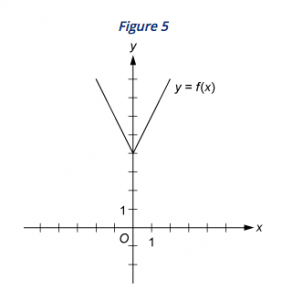
“The figure above shows the graph of the function f, defined by f(x) = |2x| + 4 for all numbers x. For which of the following functions g, defined for all numbers x, does the graph of g intersect the graph of f?”
- g(x) = x – 2
- g(x) = x + 3
- g(x) = 2x – 2
- g(x) = 2x + 3
- g(x) = 3x – 2
EXPLANATION
Here we need to find the function g that intersects with function f. Honestly, The easiest and fastest strategy on this problem is probably just to very quickly draw out the functions to see which one intersects with f.
Here’s f and choice (A), g(x) = x – 2
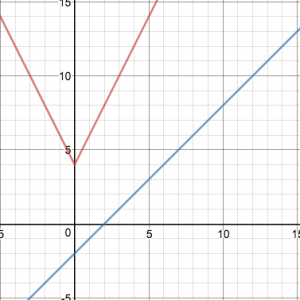
These clearly won’t intersect at any point.
Here’s f and choice (B), g(x) = x + 3
Want to improve your GRE score by 7 points? We have the industry's leading GRE prep program. Built by world-class instructors with 99th percentile GRE scores, the program learns your strengths and weaknesses through machine learning data science, then customizes your prep program to you so you get the most effective prep possible.
Try our 5-day full access trial for free:
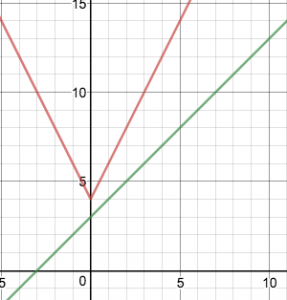
These functions also don’t intersect. Let’s move on to (C).
Here’s f and choice (C), g(x) = 2x – 2

These functions are actually parallel when x>0, so they can’t intersect for any positive values, and they obviously don’t intersect when x<0.
Moving on, here’s a graph of f and choice (D), g(x) = 2x + 3
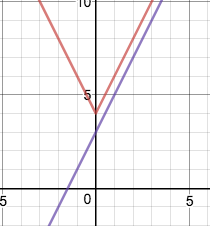
This g function is also parallel to f when x>0, so it definitely won’t intersect.
There’s only one choice left! It pretty much has to be the answer, but let’s check out the graph just in case. So here’s f and choice (E): g(x) = 3x – 2
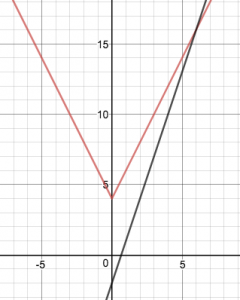
This is a match! (E) is the right answer!
This is the simplest way to solve this problem. But it’s not the only way. You can also identify the correct function from a combination of the slopes and the y-intercepts.
Since all of the g functions have positive slopes, and f(x) has a negative slope when x<0, you can infer from the y-intercepts that none of the g functions will intersect f(x) when x<0. This is because the vertex of f(x) is 4, and all of the y-intercepts of the g functions are less than 4. This means they won’t meet when x<0 because the values of all the g functions at x=0 are lower than the value of f(x) when x=0, and the g and f functions “point away” from each other, so to speak.
This means we know the correct (g) function will intersect with f when x>0. We can eliminate both of the functions with slopes of 2, choices (C) and (D), because those will run parallel to f(x) (which also has a slope of 2) and will never intersect. We can also eliminate the functions with slopes of 1, choices (A) and (B), because the value of f(x) increases too quickly for a function with a slope of 1 to “catch up.”
This leaves choice (E) with the slope of 3, which will “catch up” to f(x) and eventually exceed it in value.
TIPS for five-choice multiple choice
- Answer the question that’s being asked: This might seem obvious, but you need to answer the question that’s actually being asked. Pay close attention to words like “not” and “except,” and to the units or format your answer needs to be in. This will help prevent you from making silly mistakes. The GRE anticipates students misreading the questions and often puts in dummy answers to trick you!
- Look for shortcuts: Whenever you can avoid intensive calculations or byzantine manipulations of variables, do it! Factor, simplify, estimate—do what you can do to cut down on the crunching.
- Plug in answers: Conversely, if you don’t really know how to solve a multiple-choice question that asks you to solve for a value, you can almost always find the answer by plugging the choices back in. Start with the ones that seem the most reasonable to save time and cut down on crunching. This is a little bit like using a chainsaw when scissors would suffice, but it will get the job done, albeit somewhat inefficiently.

Multiple-Answer Multiple Choice
These are the directions from ETS for multi-answer multiple choice:
“Directions: Select one or more answer choices according to the specific question directions. If the question does not specify how many answer choices to select, select all that apply.The correct answer may be just one of the choices or as many as all of the choices, depending on the question.
No credit is given unless you select all of the correct choices and no others.
If the question specifies how many answer choices to select, select exactly that number of choices.”
Example Multiple-Answer Multiple Choice
“Each employee of a certain company is in either Department X or Department Y, and there are more than twice as many employees in Department X as in Department Y. The average (arithmetic mean) salary is $25,000 for the employees in Department X and $35,000 for the employees in Department Y. Which of the following amounts could be the average salary for all of the employees of the company?Indicate all such amounts.”
- $26,000
- $28,000
- $29,000
- $30,000
- $31,000
- $32,000
- $34,000

EXPLANATION
For this question, we have to select all possible averages salary values for the company employees. Since the two departments, respectively, have average salaries of $25,000 and $35,000, we know that the average has to be between those values. A glance at the answers, however, reveals that all of the possible answers are between $25,000 and $35,000, so that doesn’t help very much.
However, we also know that there are more than twice as many employees in Department X (with the $25,000 average salary) than in Department Y (with the $35,000 average salary). Since there are more employees in X than Y, the average salary has to be closer to $25,000 than $35,000, so we can eliminate all the answers $30,000+ right off the bat.
There are more than twice as many employees in Department X than Y. This means that, at maximum, a little more than ⅔ of the company is in Department X and a little less than ⅓ is in Department Y.
This means that the absolute maximum approximate value of the average would be (⅔)($25,000) + (⅓)($35,000) = $28,332. The only possible average values must be below that. So answers (a) and (b), $26,000 and $28,000, are the correct answer choices.
Tips for Multi-Answer Multiple-Choice
- Estimate: Multi-answer multiple choice questions are often good opportunities for judicious estimation. For example, when you need to select all the numbers that meet a particular criteria, you can usually exclude some number of answers based on preliminary estimation. We did this in the question above; because we knew there were more employees in Department X than in Department Y, we knew the company average salary had to be closer to the Department X average salary and eliminated all the salaries that weren’t closer to the Department X average.
- Select the right number of answers: Not all multiple-answer multiple-choice questions have the exact same parameters. Some require you to select all answers that meet certain criteria, while others require you to select two or even three answers. For example, some questions ask you to select the two answers that together have a product greater than a certain number. Make sure you are closely following the directions in that regard!
Want to improve your GRE score by 7+ points?
Check out our best-in-class online GRE prep program. We guarantee your money back if you don't improve your GRE score by 7 points or more.
PrepScholar GRE is entirely online, and it customizes your prep program to your strengths and weaknesses. We also feature 2,000 practice questions, official practice tests, 150 hours of interactive lessons, and 1-on-1 scoring and feedback on your AWA essays.
Check out our 5-day free trial now:

Numeric Entry
Here are the directions for Numeric Entry questions: “Directions: Enter your answer as an integer or a decimal if there is a single answer box OR as a fraction if there are two separate boxes — one for the numerator and one for the denominator.”
Example Numeric Entry
“Results of a used-car auction:
| Small Cars | Large Cars | |
| Number of cars offered | 32 | 23 |
| Number of cars sold | 16 | 20 |
| Projected sales total for cars offered (in thousands) | $70 | $150 |
| Actual sales total (in thousands) | $41 | $120 |
For the large cars sold at an auction that is summarized in the table above, what was the average sale price per car?”
EXPLANATION
Don’t get overwhelmed by all the information here—figure out what you need to know and focus on that. So what do you need to know to answer this question?
Well, you are trying to figure out the average sale price per large car. To figure out the average, you need to know the number of large cars sold and the total sales in $ of large cars. So let’s find that information in the table!
We can completely ignore the “Small Cars” column; the question isn’t asking anything about those. We can also ignore the “cars offered” and “projected sales totals.” We want to know the actual number of cars sold, not offered, and we want to know the actual sales, not projected sales.
We can see in the table that 20 large cars were sold. For actual sales totals, we can see $120 in the large cars column—but these are in thousands. Thus, the actual sales total in dollars is $120,00.
We have enough information to calculate the average now. $120,000 total sales / 20 large cars sold = $6000 per car. So, the answer is $6000!
Tips for Numeric Entry
- Make sure the answer is in the correct format: Numeric entry questions sometimes ask for the answer in a very specific format—e.g. as a fraction, in particular units, rounded to two decimal places, etc. Be sure that your answer is in that format. It’s a waste of easy points if you can do the math but lose the credit because you forgot to convert inches to yards or something like that.
- Be careful when transferring your calculator display: Because the format of the answer is so critical, be sure that the format is correct when you transfer your calculator display. Sometimes the answer should be rounded; transferring obviously won’t do this for you. For this reason it can be safer to just type in the answer instead of transferring the calculator display.

GRE Math Study Guide: How to Prepare
Here’s our five-step GRE math study guide to help you conquer the quantitative GRE section through proper preparation:
Step 1: Learn Question Formats
The very first thing to do when you’re preparing for GRE quant is to learn the various formats of the quant questions. This will help you feel oriented to the tasks you’ll need to complete for the test. It will also make you more comfortable and confident when you encounter these question types.
Luckily, if you’ve made it this far into the article, you’ve already learned about all of the different question formats, so you can proceed to step two!
Step 2: Set a Baseline and Goal Score
To be sure that you get the score you want, you need to know both where you’re starting from and how much you need to improve. This means you need to establish your baseline Quant score and then set a goal score for the section
To establish a Quant baseline, take a complete, scored, and timed Quant section. That breaks down to two subsections or 40 questions. I actually advise taking an entire PowerPrep test to set your baseline for the entire test anyways, as establishing an overall baseline is an essential part of any GRE study plan.
The score that you get from taking your initial complete Quant section is your baseline score. Once you have that, it’s time to determine your goal score for Quant.
How do you figure out a goal score? First, look up the average GRE Quantitative scores of all the programs that you are interested in. Then, take the highest number, add 1-2 points to create a good buffer. That’s your goal score! If you want, you can read more on setting goal scores, including the logic behind the above process. This article also has advice on what to do if your programs of interest don’t provide a whole lot of information on necessary scores.
Step 3: Make a Study Plan
Once you’ve established your baseline and goal scores, you are ready to make a study plan. First, establish how long you’ll need to study to bring your baseline score (where you are now) up to your goal score (where you want to be by test day).
Here are our expert estimates for how many hours it takes to improve your score by a particular point amount:
- 5 points = 40 hours
- 10 points = 80 hours
- 20 points = 160 hours
- 30 points = 240 hours
So, if your baseline is 158, and you want to get up to 168, expect to spend about 80 hours studying.
Once you know the total amount of hours you need to study, divide that by the number of weeks you have until the test. So if I need to spend 80 hours studying and I have 10 weeks until my test, I need to spend about 8 hours a week every week studying.
It helps to set particular, consistent windows of time for GRE prep during the week. This will make it feel routine and keep you from falling behind.
You can get more information on making a study plan for the entire GRE test in our total expert how-to.

Step 4: Learn and Review Content
Now it’s time to fill in the gaps in your math knowledge. You may already have a general idea of what areas you are weak in, but a good way to establish the content areas you really need to address is look back at what questions you missed on your baseline. Did you miss almost all the exponent questions? Maybe you found yourself guessing on Data Interpretation. Or perhaps graphs of functions have you lost. Any consistent patterns of weakness among your wrong answers can point you to content areas to address.
Of course, you’ll need materials to review and practice math content. ETS, the makers of the GRE, publish a GRE quantitative review PDF. It’s a good place to start, but unless you’re a pretty advanced math student already, you’ll probably need to supplement it with other content review materials.
There are a few places where you can get math review and content practice:
- If you happen to have access to any of your old math textbooks, you might look through those—they’ll be full of math lessons and practice problems.
- You might also try a good, math-focused GRE prep book.
There are also a variety of online resources out there:
- Khan Academy offers math review in many of the areas tested on the GRE.
- MathPlanet offers free lessons in algebra 1 and 2 and geometry, containing lots of information on concepts tested on the GRE.
- For practice that will really stretch your brain and help you think outside the box—a valuable skill for identifying shortcuts in tricky GRE quantitative problems—sign up for a free Brilliant.org account and get access to a number of questions in GRE-content areas with fairly robust explanations. You can pay money to access more, but there’s a pretty good stock available for free.
- For clarification on specific concepts, you might try Wolfram’s MathWorld—basically the Wikipedia of math.
- And check out our GRE math cheat sheet with all the formulas you need to know.
A final critical thing as you learn math content is to cultivate the right attitude. Don’t tell yourself you’re bad at math! Lots of people believe they are not good at math. Even people who perform quite well in math courses and on math tests often believe that they are not actually good at math.
As you might imagine, this attitude does not make it easier for you to do well on stressful math examinations like the GRE quantitative section. So instead, focus on the things you already know and how good you are at those things. When you master new concepts, feel proud and confident! Believing you can do it will make it much easier to actually do it.

Step 5: Test Practice and Strategy
Once you’ve strengthened the underlying foundations of math knowledge that the GRE quant section tests, you’re ready to practice specifically for the GRE quant section. That means finding (and completing) as many high-quality practice tests and questions you can find until you feel totally confident in your ability to make that goal score!
Here are some places to look for quantitative GRE section practice:
- The best resources for practice GRE quantitative questions come from ETS, the makers of the GRE. Find all of their practice tests and see our tips here.
- You can also find a huge number of GRE math practice resources online.
- Prep books are another great source of GRE practice questions once you’ve exhausted the official ETS resources.
And here are my tips for getting the most out of GRE quant practice questions:
- Use a realistic calculator. The GRE calculator is pretty simple—it’s basically a simple scientific calculator. So when you’re doing practice questions on an interface that doesn’t provide an online calculator, leave your fancy graphing calculator in the drawer and use a more basic one instead. That way you won’t be relying on features that you won’t have access to on test day, and you’ll get used to solving the problems with only the specific calculation functions available to you.
- To really imitate the experience of taking the GRE quant section, take accurately timed practice sections. This will help you know where you stand in terms of pacing, and provide valuable practice of doing the questions under time pressure.
- Use scratch paper: Whether you’re doing computer-based practice or sections out of a book, use separate sheets of scratch paper to do your calculations. This will help you hone your scratch paper strategy and get used to having to do your calculations on a separate piece of paper before test day.
- Analyze your mistakes: For GRE prep, mistakes are a gold mine. When you look back at your mistakes, you want to identify why you got the question wrong. Did you mis-read it? Did you run out of time? Maybe you didn’t know the concept well enough or you made a calculation error. When you identify patterns in your mistakes, you know that’s something you need to target.
- Look for shortcuts when you review your answers: While it ultimately doesn’t matter how you get the answer on a GRE question just so long as you get it, using shortcuts will help you get through questions faster. Then you can use extra time on more difficult questions, to review your answers, etc. So when you do review your answers, consider if there were any shortcuts or easier ways to solve the question that you missed. Then you can try to incorporate those shortcuts into future practice and ultimately use them on GRE quantitative test day.

GRE Math Tips for Test Day Success
Here are the tips you need for acing GRE quantitative on test day!
Answer Easy Questions First
Here’s the thing: every question on the GRE quantitative section is worth the same amount of points. This goes for all the numeric entry, all the multiple-answer multiple choice, and so on. Each individual question is worth the same as every other question.
This means that it’s only logical to answer the questions that are easy for you first. Those are the points you know you can get; get them! Then circle back on a second pass for the questions that are more difficult or will take longer for you to solve.
If You Get Stuck, Move On
Staring in blank confusion or abject frustration at problem you aren’t sure how to approach is a huge waste of time. If you have no idea how to answer a question, move on as soon as you realize it. Similarly, if you’ve sunk 90 seconds in a question with no answer in sight, cut your losses and try again on a second pass. It will probably all be much clearer the second time around, and if it’s not, you can guess the answer knowing that you didn’t waste that time.
Stay Confident
Remain confident in yourself throughout the exam. Don’t panic as soon as you forget a formula or come across something you don’t remember how to do. You prepared for the test and you’re ready for it. Don’t be thrown by minor setbacks; just move on from any challenging or confusing questions and come back later.
Read Questions Carefully
It’s critical that you read questions carefully to avoid silly mistakes. There’s nothing worse than leaving points you can actually get on the table because you were careless and you didn’t see the “except” or “not” in the question, or you presented your answer in the wrong units.

Answer the Right Question
The GRE quantitative section often provides you with a bunch of information that you could use to do a whole bunch of different calculations. But don’t just do whatever calculation seems natural and spit that back out. Make sure that you are actually answering what the question is asking.
Present Answer in Correct Format
The GRE frequently asks for answers in a very specific format. It may not be the format you expect, either. For example, maybe they gave you all the information in dollars, and they want the answer in cents. So be sure that you are giving the answer in the correct format and units. This is especially salient for numeric entry, but it can also be a trap in multiple choice questions, where there are often answer choices that are just partially solved versions of the right answer—i.e. the answer before you convert into the correct units. Don’t be tricked by this!
Don’t Get Overwhelmed by Details
GRE questions often give you more information than you need to solve them. This is especially true for Data Interpretation questions. But don’t let your head get turned around by all of the minute details—instead, first figure out what the question is asking, and then go back and see what is relevant to the question among the information you’ve been given. Then go from there.
Make Good Use of Scratch Paper
You’re given an unlimited amount of scratch paper on the GRE. You’ll start with three sheets, but you can ask for more. So make good use of it! Diagram figures, do calculations, graph functions—do what you need to do to make it easier to grasp the questions.
However, it’s critical that you write neatly and clearly. If you haphazardly scribble down calculations every which way in all directions, not only are you increasing the chances that you’ll misread something you’ve written, you probably aren’t using your paper very efficiently. The paper is unlimited, but you’ll waste time if you’re asking for three more sheets every 5 minutes.

Estimate When Appropriate
Whenever you can estimate on the GRE to solve the question instead of doing more granular calculations, you’ll save time. Obviously, this won’t work on every question, particularly when the question asks for some kind of very exact answer to calculations. But if, for example, you’re comparing 48% of 500 and 21% of 1500, it makes sense to just compare 50% of 500 (250) and 20% of 1500 (300) to get the correct answer.
Slow Down If Necessary
For most of the quant section, you’ll want to move along at a fairly fast clip, as you’re only allotted about 1:45 per question. However, some questions will probably take you a lot less time than that, so you can afford to spend a little extra time on questions that you find more difficult or time-consuming. If you force yourself to just do everything as quickly as possible, you’ll be more prone to making careless math mistakes. It’s better to move a little bit more slowly and actually do the math correctly.
Answer Every Question
The GRE has no guessing penalty, so it’s to your advantage to answer every question even if you have to more or less guess randomly. While it’s highly unlikely that you’ll guess correctly on a Numeric Entry question, your odds on the other question types aren’t awful. This is especially true if you can eliminate answers you know are incorrect. If you can eliminate even one Quantitative Comparison answer, for example, you have a 33% chance of guessing correctly.
Plug in Answers
When in doubt, plug in the answers for multiple choice questions. It’s certainly not the strategy with the most finesse, but it will typically get the job done and you’ll get the points.
However, if you find yourself needing to plug in answers for lots of questions in every subsection, you probably have some foundational math content weaknesses to address.
How You Get the Answer Doesn’t Matter
Remember that how you get the answer doesn’t matter—it’s all worth the same amount of points whether you solved it the “right” way or not. While it’s true that there’s usually a most efficient way to solve a particular problem, don’t get hung up on figuring that way out. If you spend too much time looking for shortcuts instead of just using a method you know works, you’ll end up wasting time in the long run. In the end, it’s all about finding that balance between efficiency and accuracy.

Extra Tips for a Perfect Score
Here are some extra tips if you are going for the perfect 170 on Quant.
Know How Many You Can Get Wrong
Unlike on the Verbal section, where you can typically afford to get one question wrong and still get a 170, on Quant, you’ll need to get every question correct for a 170.
Hone in on Your Mistakes
While it’s always important to analyze your mistakes in GRE prep, if you are going for a perfect score, you need to identify your weaknesses on a micro-level. It’s not enough to know that you struggle with questions on exponents—what specifically about exponents tricks you up? Subtracting and adding them? Doing multiplication and division? Do you have trouble working with exponents with the same base, or different bases? These are subtly different weaknesses, and you need to address your specific issues very closely to be able to get that perfect score.
To this end, I advise taking very specific notes on any questions you get wrong. Note down the question and do your best to identify exactly what tripped you up. Also write down the strategies you used to try to solve the question, and if you felt rushed, stressed, etc. Look back at your work, too, to pinpoint areas where you went wrong. Noting these patterns can help you identify weaknesses that aren’t content-based—are you rushing through the last few questions? Are you making silly math mistakes? Are you forgetting to put answers in the right format?

Practice With Extra-Hard Questions
One oft-advised strategy if you’re going for a top score is to practice with questions that are actually more difficult than the actual GRE. By comparison, the actual test will be easier, and then you’ll have an easier time acing it!
Of course, it’s important that the questions aren’t just harder, but that they actually test the same math skills as the GRE. To that end, questions specifically designed for GRE prep are probably your best bet. The most difficult questions in the Manhattan Prep 5-lb Book of GRE Practice Problems, as well as “hard” and “very hard” questions in Nova’s GRE Math Prep Course, are good options for this.
Double-Check Your Answers
Many students won’t really have time to look back over their answers on GRE quantitative—it’s a high time-pressure situation, after all. However, if you’re going for that perfect score, you’re probably already quite good at math, and chances are you may find yourself with a couple of extra minutes left in the section.
Since a perfect score means no wrong answers, quickly double-checking your answers for any obvious mistakes at the end of the section is very important. While you almost certainly won’t have time to re-do most calculations, you can make sure that you answered the correct question, that you typed what you meant to type for numeric entry, that you followed the directions for multi-answer multiple-choice, and so on.

Review: GRE Quant Study Guide
In this total guide to acing GRE quantitative, we’ve gone over everything you need to know to crush the GRE math section. We went over the quant section’s format and content areas and gave examples, explanations, and tips for each question type.
We provided a five-step GRE math study guide:
- Learn question formats
- Establish a baseline and goal score
- Make a study plan
- Learn foundational math content
- Practice math GRE questions and sections!
Lastly, we wrapped up with GRE math tips for test-day and extra-special additional strategies for those going for that perfect 170!

What’s Next?
If you’re hunting up more resources for the GRE quantitative section, check out our complete list of the best GRE math resources, our four expert tips for the GRE calculator, and our GRE math cheat sheet.
Need help with GRE Verbal? See our 357 critical GRE words you must know and the best GRE Verbal practice you can find out there!
For more general GRE help, see our GRE FAQ to answer all your burning GRE questions, 34 expert GRE tips and strategies, an ultimate GRE study guide, and our master collection of all the GRE tests out there.
Ready to improve your GRE score by 7 points?
We've written a eBook about the top 5 strategies you must be using to have a shot at improving your GRE score.
Download it for free now:

